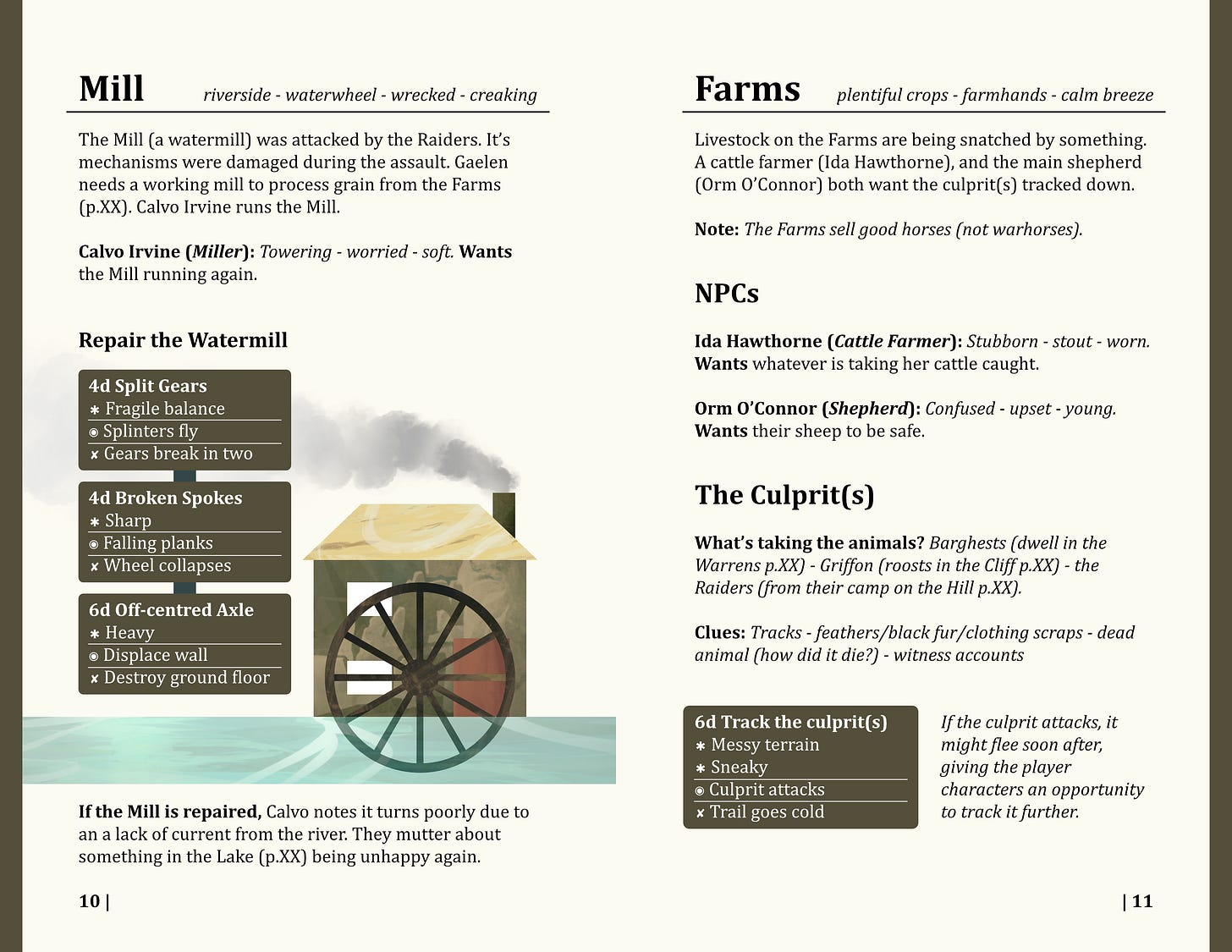This article contains affiliate links, meaning I get a commission if you make purchases using these links, at no cost to you.You know when it’s time to roll initiative? Everyone has to roll a die, do some maths, hand a number to the GM, then the GM needs to order all the numbers…
Can we go yet!?
When initiative is slow, tension grinds to a halt. Let’s fix that.
Initiative is the rule used to determine the order characters act in when you want a turn structure in your game. I like:
Quick initiative.
Making it easy for players to plan and work together.
Here’s some approaches you can adapt to a lot of TTRPGs.
Freeform (no initiative)
This is the approach most of the time during games, and there’s no reason why you can’t use it for everything. Whoever acts first goes first, then other characters act as makes sense. The GM ensures everyone gets a chance to act.
This is how Grimwild runs initiative. Grimwild is a cinematic fantasy RPG that you should can make late pledges for on Backerkit now. It’s really cool. I’ve been asked to write the first two modules for it and it’s sweeet! Check out the (unedited) work in progress teaser below.
Nominated
Whoever acts first goes first, then they nominate who goes next and so on until every character has a turn. The last character decides who starts the next round, and can choose themselves. This is collaborative and interactive, which I love. My favourite sci-fi game Death in Space uses this system
Side
Based on who acts first, either all the players go first (choosing their own order) or all the GM characters go first. The other ‘side’ goes next, then you continue switching between each side.
Option: Roll to determine who goes first. For example - roll a d6. On a 1-3, the GM side is first. On a 4-6, the players are first. Mork Borg does this.
Alternating Sides
Just like the Side approach, but alternate between sides per turn e.g. if a player goes, then one of the GM’s characters goes next (and vice versa). Players/GM decide who acts when it’s their side’s turn. Switch between sides until everyone has gone, then repeat.
If one side has more characters, take successive turns when the other side has run out of characters. You can use the option of rolling to decide who goes first (see above).
Checked Sides
Player characters each make a check. Players that succeed go first, choosing their order amongst themselves. Players that fail go after the GM’s side, again choosing their order amongst themselves. Then switch between each side.
This is good for games where initiative-relevant abilities are built in. If a character has ‘+5 to initiative’, that applies to their check.
Option 1: Give bonuses/penalties to the check e.g. a bonus for staging an ambush.
Option 2: Use different checks per situation e.g. dexterity when movement wins and wisdom when awareness wins.
~Psst. If you like your initiative complex and tactical, that’s cool too. If tension for you is mechanical, play into that.~
If initiative has been taking forever and killing tension at your table, try one of these. Let me know you get on over on the Murkdice Discord.
Recommendations
Book: The Caverns of Caarn is a free adventure for the infamous Vaults of Vaarn. It’s a depth crawl, which employs modular tables to determine exits from different levels, as well as additional details for locations. I really enjoyed the structure, and may use something similar in my main campaign soon.
YouTube: Seth Skorkowsky starts reviewing a Mongoose Traveller 2e campaign book, Secrets of the Ancients. Module reviews are becoming my favourite content as I become more and more obsessed with adventure design. Seth does a great job of breaking down the first scenario in this book, what it does well, and some pain points. Check out the module here.







I think some systems - without necessarily always spelling it out - demand a particular initiative system. If there are mechanical features that provide concrete bonuses to character initiative, one can’t really adopt a looser turn order system without rendering some player choices redundant. This is one of those cases where tinkering should probably only be attempted once one has enough of a handle on the system to understand the downstream consequences of the decision to depart from the RAW. In games with granular combat mechanics I’m a fan of ‘shifting initiative’ whereby, once established (by whatever means as discussed) characters (and sometimes opponents) can act at any point on or after their initiative to take advantage of the tactical situation as it evolves. Sometimes when a character holds their action, the stage at which they choose to act on the first round becomes their default initiative order for the rest of the encounter but I prefer systems that allow for dynamic initiative that combines rolling initiative every round and allowing for the ‘hold’ mechanic. In any abstracted or rules lite system - which usually equates to a more narrative style - then I’m happy to allow players to determine when they act in each round, but I reserve the right - if it fits with the scene as it has played out in previous rounds - to declare by fiat when opponents act and this might be before the PCs in some circumstances.